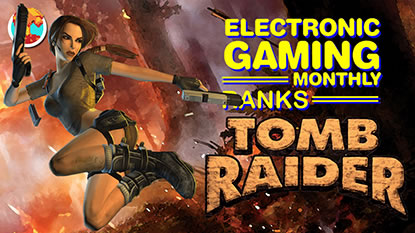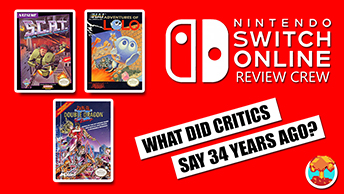- CLASSIC MAGAZINES
- REVIEW CREW
A show recapping what critics thought back
when classic games first came out! - NEXT GENERATION'S BEST & WORST
From the worst 1-star reviews to the best
5-stars can offer, this is Next Generation! - NINTENDO POWER (ARCHIVE)
Experience a variety of shows looking at the
often baffling history of Nintendo Power! - MAGAZINE RETROSPECTIVE
We're looking at the absolutely true history of
some of the most iconic game magazines ever! - SUPER PLAY'S TOP 600
The longest and most ambitious Super NES
countdown on the internet! - THEY SAID WHAT?
Debunking predictions and gossip found
in classic video game magazines! - NEXT GENERATION UNCOVERED
Cyril is back in this spin-off series, featuring the
cover critic review the art of Next Generation! - HARDCORE GAMER MAGAZING (PDF ISSUES)
Download all 36 issues of Hardcore Gamer
Magazine and relive the fun in PDF form!
- REVIEW CREW
- ELECTRONIC GAMING MONTHLY
- ELECTRONIC GAMING MONTHLY RANKS
From Mario to Sonic to Street Fighter, EGM
ranks classic game franchises and consoles! - ELECTRONIC GAMING MONTHLY BEST & WORST
Counting down EGM’s best and worst reviews
going year by year, from 1989 – 2009! - ELECTRONIC GAMING BEST & WORST AWARDS
11-part video series chronicling the ups and
downs of EGM’s Best & Worst Awards!
- ELECTRONIC GAMING MONTHLY RANKS
- GAME HISTORY
- GAME OVER: STORY BREAKDOWNS
Long-running series breaking down game
stories and analyzing their endings! - A BRIEF HISTORY OF GAMING w/ [NAME HERE]
Real history presented in a fun and pithy
format from a variety of game historians! - THE BLACK SHEEP
A series looking back at the black sheep
entries in popular game franchises! - INSTANT EXPERT
Everything you could possibly want to know
about a wide variety of gaming topics! - FREEZE FRAME
When something familiar happens in the games
industry, we're there to take a picture! - I'VE GOT YOUR NUMBER
Learn real video game history through a series
of number-themed episodes, starting at zero! - GREAT MOMENTS IN BAD ACTING
A joyous celebration of some of gaming's
absolute worst voice acting!
- GAME OVER: STORY BREAKDOWNS
- POPULAR SHOWS
- DG NEWS w/ LORNE RISELEY
Newsman Lorne Riseley hosts a regular
series looking at the hottest gaming news! - REVIEW REWIND
Cyril replays a game he reviewed 10+ years
ago to see if he got it right or wrong! - ON-RUNNING FEUDS
Defunct Games' longest-running show, with
editorials, observations and other fun oddities! - DEFUNCT GAMES QUIZ (ARCHIVE)
From online quizzes to game shows, we're
putting your video game knowledge to the test!- QUIZ: ONLINE PASS
Take a weekly quiz to see how well you know
the news and current gaming events! - QUIZ: KNOW THE GAME
One-on-one quiz show where contestants
find out if they actually know classic games! - QUIZ: THE LEADERBOARD
Can you guess the game based on the classic
review? Find out with The Leaderboard!
- QUIZ: ONLINE PASS
- DEFUNCT GAMES VS.
Cyril and the Defunct Games staff isn't afraid
to choose their favorite games and more! - CYRIL READS WORLDS OF POWER
Defunct Games recreates classic game
novelizations through the audio book format!
- DG NEWS w/ LORNE RISELEY
- COMEDY
- GAME EXPECTANCY
How long will your favorite hero live? We crunch
the numbers in this series about dying! - VIDEO GAME ADVICE
Famous game characters answer real personal
advice questions with a humorous slant! - FAKE GAMES: GUERILLA SCRAPBOOK
A long-running series about fake games and
the people who love them (covers included)! - WORST GAME EVER
A contest that attempts to create the worst
video game ever made, complete with covers! - LEVEL 1 STORIES
Literature based on the first stages of some
of your favorite classic video games! - THE COVER CRITIC
One of Defunct Games' earliest shows, Cover
Critic digs up some of the worst box art ever! - COMMERCIAL BREAK
Take a trip through some of the best and
worst video game advertisements of all time! - COMIC BOOK MODS
You've never seen comics like this before.
A curious mix of rewritten video game comics!
- GAME EXPECTANCY
- SERIES ARCHIVE
- NINTENDO SWITCH ONLINE ARCHIVE
A regularly-updated list of every Nintendo
Switch Online release, plus links to review! - PLAYSTATION PLUS CLASSIC ARCHIVE
A comprehensive list of every PlayStation
Plus classic release, including links! - RETRO-BIT PUBLISHING ARCHIVE
A regularly-updated list of every Retro-Bit
game released! - REVIEW MARATHONS w/ ADAM WALLACE
Join critic Adam Wallace as he takes us on a
classic review marathon with different themes!- DEFUNCT GAMES GOLF CLUB
Adam Wallace takes to the links to slice his way
through 72 classic golf game reviews! - 007 IN PIXELS
Adam Wallace takes on the world's greatest spy
as he reviews 15 weeks of James Bond games! - A SALUTE TO VAMPIRES
Adam Wallace is sinking his teeth into a series
covering Castlevania, BloodRayne and more! - CAPCOM'S CURSE
Adam Wallace is celebrating 13 days of Halloween
with a line-up of Capcom's scariest games! - THE FALL OF SUPERMAN
Adam Wallace is a man of steel for playing
some of the absolute worst Superman games! - THE 31 GAMES OF HALLOWEEN
Adam Wallace spends every day of October afraid
as he reviews some of the scariest games ever! - 12 WEEKS OF STAR TREK
Adam Wallace boldly goes where no critic has
gone before in this Star Trek marathon!
- DEFUNCT GAMES GOLF CLUB
- DAYS OF CHRISTMAS (ARCHIVE)
Annual holiday series with themed-episodes
that date all the way back to 2001!- 2015: 30 Ridiculous Retro Rumors
- 2014: 29 Magazines of Christmas
- 2013: 29 Questionable Power-Ups of Christmas
- 2012: 34 Theme Songs of Christmas
- 2011: 32 Game Endings of Christmas
- 2010: 31 Bonus Levels of Christmas
- 2009: 30 Genres of Christmas
- 2008: 29 Controls of Christmas
- 2007: 34 Cliches of Christmas
- 2006: 33 Consoles of Christmas
- 2005: 32 Articles of Christmas
- 2004: 31 Websites of Christmas
- 2003: 29 Issues of Christmas
- 2002: 28 Years of Christmas
- 2001: 33 Days of Christmas
- NINTENDO SWITCH ONLINE ARCHIVE
- REVIEW ARCHIVE
- FULL ARCHIVE
Before Dreamcast: Cracking Sega's Cryptic Marketing Campaign
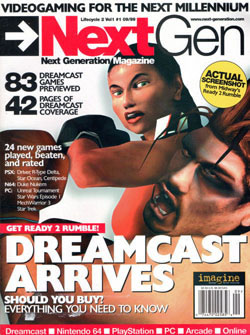
Next Generation magazine was ready for the Dreamcast's arrival!
Although it only stuck around for a total of 19 months (29 in Japan), the Dreamcast's short life still feels important. A lot of this is due to a strong library that not only included some of Sega's strongest arcade games (Sega Rally 2, Crazy Taxi, etc.), but also daring original titles like Shenmue, Phantasy Star Online, Space Channel 5 and Rez. Although it was overshadowed by the likes of Sony's PlayStation 2, Microsoft's Xbox and Nintendo's GameCube, gamers around the world still love Sega's final home console.
With a year head start, Sega chose to introduce their Dreamcast in an unusual way. Taking a page out of Sony's confusing PlayStation campaign, the hardware giant chose to create a line print ads with cryptic messages. They hoped that the "It's Thinking" tagline would capture the mass market's curiosity in the same way that "U R NOT E" and "ENOS Lives" had only a few years earlier.
In the months leading up to the ninth of September, Sega released a series of bizarre print ads in magazines like Next Generation, Electronic Gaming Monthly and Game Informer. These single-page advertisements featured no mention of games, instead choosing to focus on close-ups of eyeballs and bald men. Throw in what appears to be unintelligible gibberish in braille and you have a commercial that still makes very little sense 15 years later.
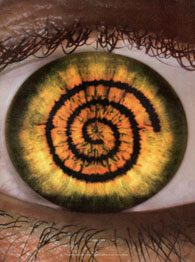
Sega Dreamcast Teaser Advertisement
Published several months before the launch of the Dreamcast, this was Sega's first teaser. It featured a close-up of an eye with that all-too-familiar swirl. There's no mention of the console, not even in the fine print. Unless you noted the "Sega.com" URL or were familiar with Dreamcast's unique symbol, you would likely come away from this commercial scratching your head. On the other hand, there's a good chance you would remember that swirl the next time you saw it.
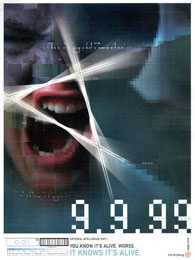
Sega Dreamcast Commercial 0.01
This first commercial (marked "0.01") features what seems to be a very angry young man. He's a little out of focus and pixelated in parts, but it's clear that he's upset about something. While Sega would probably argue that this screamer would feel better with a new Dreamcast, I suspect what he needs is actual medication and anger management classes. "You know it's alive," the advertisement states. "Worse. It knows it's alive." Is this a commercial for a new Sega console or a low-budget horror film? With this image, it's hard to tell.
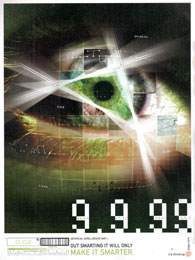
Sega Dreamcast Commercial 0.02
The second commercial is a little less agro, opting instead to highlight the eye. It's curious that Sega would choose to focus on the eye so soon after their similarly-themed teaser spot, but at least this version has a unique take. This is a much more interesting advertisement, thanks to a number of small details hidden throughout the page. Each square panel has a slightly different filter, and it has a strange A Clockwork Orange vibe. The ad concludes with this ominous quote: "Out smarting it will only make it smarter."
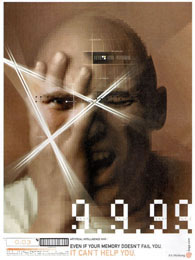
Sega Dreamcast Commercial 0.03
The third and final ad offers the clearest image yet, but that doesn't mean the message is any easier to decipher. The advertisement features a bald man covering one eye with his right hand. But that's not the weird part. For whatever reason, we can see his eye peeking through his hand, almost as if his hand was completely non-corporeal. If that's not strange enough, the slogan offers this curious line: "Even if your memory doesn't fail you. It can't help you."
After running these cryptic messages for a couple months, Sega decided to create an insert that, at long last, explained what the Dreamcast was all about. Best of all, it included the images and names of two dozen titles from some of the biggest publishers in the world. This eight page fold-out also included information about the system's bulky controller, Visual Memory Unit and 56K modem.

Click here to see the full advertisement!
Although it still offers a few confusing quotes, this launch advertisement does cuts back on the weirdness and delivers a cohesive message. But while I commend this commercial for being more on message, I can't help but notice all the unused space. Only Sonic Adventure and NFL 2K get the full-page treatment, while the other 24 titles fight for space on a single page. I don't know what the Dreamcast was thinking of, but it clearly couldn't be bothered with coming up with a more efficient design.
No matter what you thought of Sega's approach, you can't argue with the results. The Dreamcast was a huge hit in the United States, selling closer to 400,000 units in just only four days. A surprised news media was quick to compare Sega's $132 million in sales to the much-anticipated Star Wars prequel, which "only" brought in $65 million in its opening weekend.

Click here to see the full advertisement!
For a few weeks in 1999, it truly felt like the Dreamcast was unstoppable. Unfortunately, Sega wasn't having as much luck overseas. Couple this with the threat of three major consoles (and a lack of Electronic Arts sports games) and Sega wasn't able to hang on. The video game giant exited the hardware market in March of 2001, leaving to become a celebrated third-party publisher.
For a few weeks in 1999, it truly felt like the Dreamcast was unstoppable. Unfortunately, Sega wasn't having as much luck overseas. Couple this with the threat of three major consoles (and a lack of Electronic Arts sports games) and Sega wasn't able to hang on. The video game giant exited the hardware market in March of 2001, leaving to become a celebrated third-party publisher.
Regardless of what you think of Sega in 2014, it's important to remember that there once was a time when the Tokyo-based company was not afraid to take chances. Even if you never managed to decipher these cryptic messages, the imagery was certainly memorable. As far as I'm concerned, we could use more of that in this day and age.
HOME |
CONTACT |
NOW HIRING |
WHAT IS DEFUNCT GAMES? |
NINTENDO SWITCH ONLINE |
RETRO-BIT PUBLISHING
Retro-Bit |
Switch Planet |
The Halcyon Show |
Same Name, Different Game |
Dragnix |
Press the Buttons
Game Zone Online | Hardcore Gamer | The Dreamcast Junkyard | Video Game Blogger
Dr Strife | Games For Lunch | Mondo Cool Cast | Boxed Pixels | Sega CD Universe | Gaming Trend
Game Zone Online | Hardcore Gamer | The Dreamcast Junkyard | Video Game Blogger
Dr Strife | Games For Lunch | Mondo Cool Cast | Boxed Pixels | Sega CD Universe | Gaming Trend
Copyright © 2001-2025 Defunct Games
All rights reserved. All trademarks are properties of their respective owners.
All rights reserved. All trademarks are properties of their respective owners.













